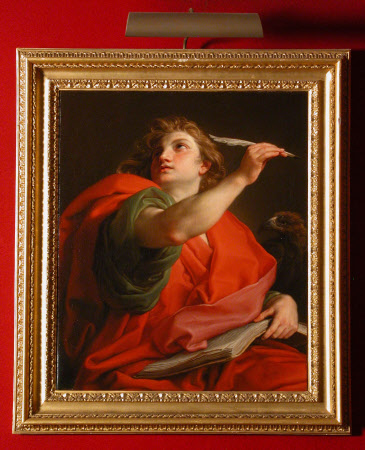Saint John the Evangelist
Pompeo Girolamo Batoni (Lucca 1708 – Rome 1787)
Category
Art / Oil paintings
Date
1740 - 1743
Materials
Oil on canvas
Measurements
730 x 605 mm (28¾ x 23¾ in)
Place of origin
Rome
Order this imageCollection
Basildon Park, Berkshire
NT 266912
Caption
Saint John holds his quill pen poised to write his Gospel, or - more probably - the Book of Revelation. To his left is an eagle - his religious attribute - the bird with the acutest sight that flies highest and nearest to heaven. This work is from a group of eight pictures now on view in Basildon Park. This group comes from a set of twelve pictures of God the Father and the Apostles, originally painted for the town palace of Count Cesare and Fra Giuseppe Merenda in Forlí. They were Batoni's most dedicated patrons, commissioning at least 32 paintings from him between about 1740 and 1750.
Summary
Oil painting on canvas, Saint John the Evangelist by Pompeo Girolamo Batoni (Lucca 1708 – Rome 1787), 1740-43. A three-quarter length, sits, looking up, left side of his face lit, brown hair, green tunic and red cloak. His left hand is holding an open book in lap while right arm held up, white quill in his hand. He is the presumed author of the fourth gospel and, by tradition, the Apocalypse, to which the pen and book allude. The eagle, on the right, is John's characterisation of a winged creature, based on a biblical passage in Ezekiel (1:5-14). Moulded gilt frame. Part of set of eight.
Provenance
Commissioned by Count Cesare (1700-1754) and Fra Giuseppe (1687-1760) Merenda, for the picture-gallery of the Palazzo Merenda, Forlì, c.1740-43; there till 1945; Villa Merenda - Salecchi, nr. Forlì, till 1959, when sold (probably via M. & C. Sestieri, Rome) to the dealer Julius Weitzner, London; with P. & D. Colnaghi & Co., London, 1959-60 [June 15 - July 16 1960 catalogue]; by whom sold in 1960 to Lord & Lady Iliffe; by whom presented to the National Trust, together with the house and grounds of Basildon Park, and a substantial part of their collection of paintings, in 1979
Credit line
Basildon Park, The Iliffe Collection (National Trust)
Makers and roles
Pompeo Girolamo Batoni (Lucca 1708 – Rome 1787), artist
Exhibition history
In Trust for the Nation, National Gallery, London, 1995 - 1996, no.54c Souvenirs of the Grand Tour, Wildenstein & Co., London, 1982, no.3
References
Calzini and Mazzatini 1893 Egidio Calzini & Giuseppe Mazzatinti, Guida di Forlì, Forlì, 1893, pp.53—54, nos. 117 or 336, 119, 87, & 90 Marcucci 1944 Luisa Marcucci, 'Pompeo Batoni a Forlì', Emporium, vol. XCIX, 1944, pp.95 n.1 (St. Peter unidentified, and St. Matthew misidentified as St. Mark) & 96 & fig.1 (St. John the Evangelist) Chyurlia 1953 Roberta Chyurlia, 'Pompeo Batoni o del classicismo Settecentesco', Emporium, vol CXVII, 1953, p.64 (repr. of St. John the Evangelist) Russell 1981 Francis Russell, 'Batoni at Basildon Park', National Trust Studies 1981, pp.35 - 42 Clark and Bowron 1985 Anthony M. Clark & Edgar Peters Bowron (ed.), Pompeo Batoni A Complete Catalogue of his Works with an Introductory Text, Oxford 1985, nos. 83

